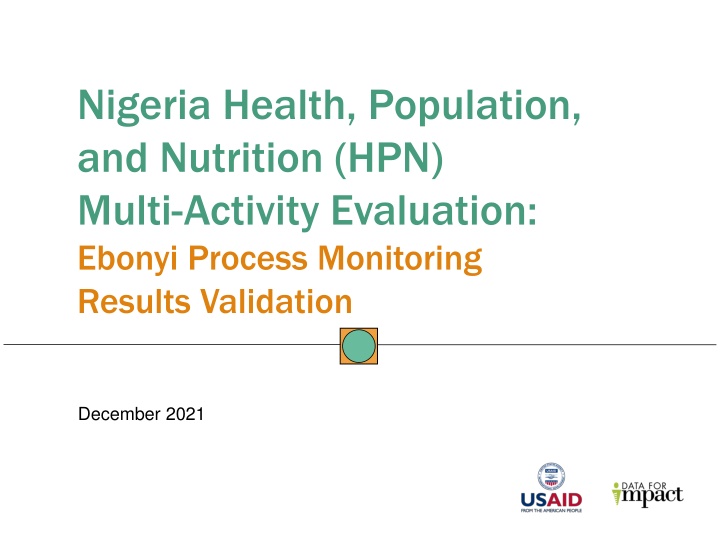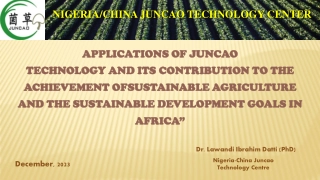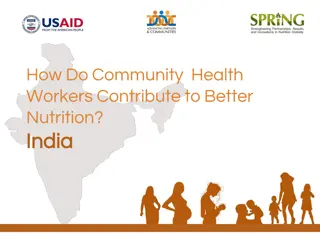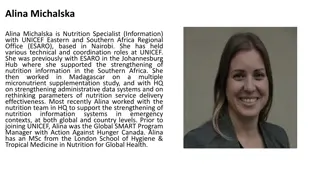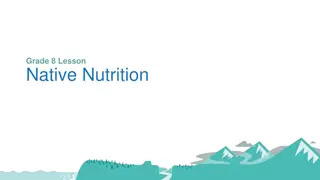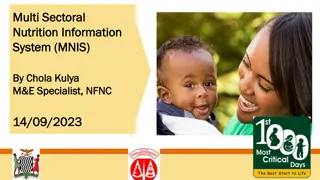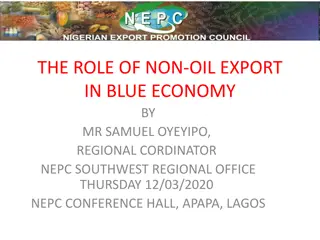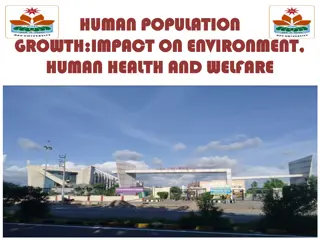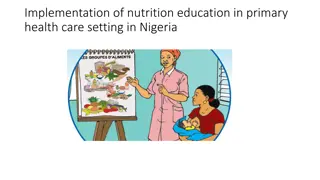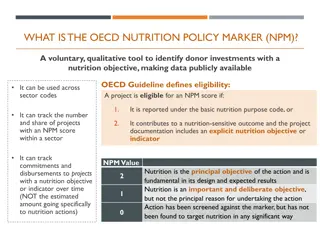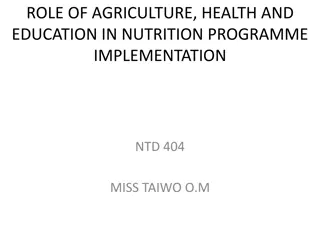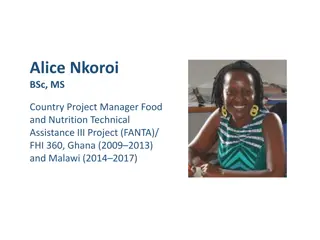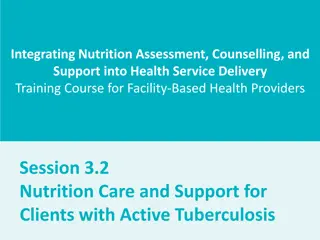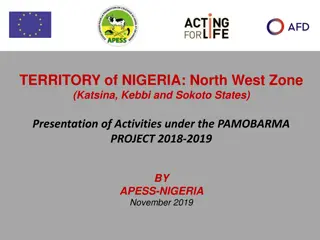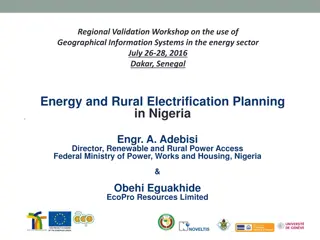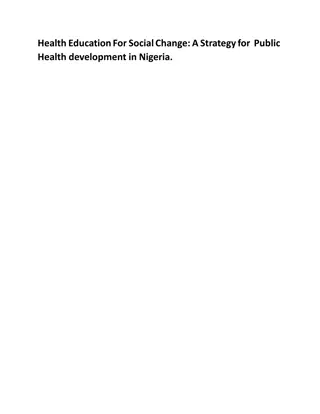Nigeria Health, Population, and Nutrition (HPN) Multi-Activity Evaluation: Ebonyi Process Monitoring
This evaluation focuses on comparing integrated health programming with a disease-focused approach in Nigeria, led by a team of experts. It includes assessments, data analysis, and qualitative components to assess impact and effectiveness.
Download Presentation

Please find below an Image/Link to download the presentation.
The content on the website is provided AS IS for your information and personal use only. It may not be sold, licensed, or shared on other websites without obtaining consent from the author.If you encounter any issues during the download, it is possible that the publisher has removed the file from their server.
You are allowed to download the files provided on this website for personal or commercial use, subject to the condition that they are used lawfully. All files are the property of their respective owners.
The content on the website is provided AS IS for your information and personal use only. It may not be sold, licensed, or shared on other websites without obtaining consent from the author.
E N D
Presentation Transcript
Nigeria Health, Population, and Nutrition (HPN) Multi-Activity Evaluation: Ebonyi Process Monitoring Results Validation December 2021
Evaluation staff Si n Curtis, PhD, Principal Investigator and Activity Lead Jessica Fehringer, PhD, Co-Investigator and Qualitative Lead Kristen Brugh, PhD, Co-Investigator and Quantitative Lead Emmanuel Adegbe, MBBS, PhD, Nigeria Co-Investigator Patrick Iyiwose, MSc, Evaluation Assistant Milissa Markiewicz, Project Manager and Research Associate Local research partner: Data Research and Mapping Consult (DRMC)
Agenda Evaluation overview Process monitoring Results Conclusion Next steps Discussion
Nigeria Health, Population, and Nutrition (HPN) Multi-Activity Evaluation Data for Impact (D4I) is conducting an outcome evaluation of four USAID/Nigeria HPN Activities with a focus on comparing the strengths and challenges of an integrated health programming approach with a disease-focused approach (malaria): Integrated Health Project (IHP) President s Malaria Initiative for States (PMI-S) Breakthrough ACTION-Nigeria (BA-N) Global Health Supply Chain Program Procurement and Supply Management (PSM)
What do we mean by an integrated approach and a disease-focused approach? An integrated approach implements a fully integrated set of RMNCH and malaria interventions as well as health system strengthening interventions (IHP). In a disease-focused approach,addresses one health area only and, in this case, the focus is on malaria (PMI-S). Both models also include demand creation (BA-N) and commodity procurement and distribution interventions (PSM).
Evaluation Components Quantitative: Health facility assessment and provider interviews (baseline and endline) DHIS2 data analysis (annual) Costing component (annual data collection) Process monitoring (annual) Organizational network analysis (midline and endline) Qualitative component with women in communities, Ward and Facility Development Committees, and health facility in-charges (midline and endline) Most significant change method workshop (midline)
Process Monitoring Process Monitoring Purpose Methods Sample
Purpose Help answer evaluation questions, monitor implementation of activities, provide contextual information Explore validity of critical coordination and implementation assumptions identified during development of portfolio-level theory of change Three case study states: oEbonyi Integrated approach with IHP (RMNCH), PMI-S (malaria), BA-N, PSM oKebbi Integrated approach with IHP (malaria and RMNCH), BA-N, PSM oZamfara Disease-focused approach with PMI-S (malaria), BA-N, PSM
Evaluation questions: Process How, and to what extent, did the four Activities and the government collaborate and coordinate to achieve desired health and service delivery outcomes? What factors facilitated or hindered collaboration and coordination? What are the most critical coordination/ collaboration points? What factors facilitated or hindered implementation among the four activities in LGAs/states where an integrated (IHP) approach was implemented, a disease-focused (PMI-S) approach was implemented, or a combination of the two?
Round 1 Round 1 of process monitoring occurred from January April 2021 and focused on: Coordination among Activities and the State Work planning Factors that facilitated and hindered coordination and implementation
Methods Interview guides informed by Activities MEL plans, result areas, and portfolio-level theory of change Selection of respondents was based on relevance of roles and engagement to objectives of evaluation: o In each state, two respondents from each Activity and two State respondents per Activity o At national level, one senior Activity staff member and one Mission staff member per Activity Matrix used to analyze results and facilitate analysis across respondents and to sort data by themes Note: Results are based on respondents perceptions
Sample: Ebonyi 24 interviews were conducted with 17 men and 7 women: 8 with state-level Activity staff 8 with State staff 4 with national-level Activity staff 4 with Mission staff
Study examined coordination and collaboration during extraordinary times (COVID-19): o Many coordination and planning meetings had to be conducted virtually and internet connectivity was problematic. o Hindered implementation. o Effect of COVID-19 may have impacted BA-N more that other IPs due to community-based nature of their work. COVID- 19
How did the four Activities and the State coordinate? Significant coordination among Activities and with the State (e.g., Activity monthly coordination meetings; quarterly meetings with the State; Activity support of State TWGs). Coordination meetings with the State allowed the State to provide input and to recommend ways to solve challenges. At the national level, Activities and Mission technical staff participate in national level TWGs and other coordination forums.
Coordination Structures and Processes Mandates Coordination support from the Mission Monthly Activity coordination meetings Co-location of offices Coordination with other development partners Activity work and implementation planning Fuzzy definition of coordination
Mandates and Mission Support Mandates: Activities result areas are tied together; coordination affects each Activity s performance. At the same time, each Activity has an individual mandate (service delivery, demand creation, commodity security) that they must balance with mandate to coordinate. Mission support: At the national level, Activities work to resolve coordination issues before they are raised by the Mission. Mission gets involved: To add value to the process or if an issue is lingering. When Activities have challenges coordinating with the State.
Monthly Activity Coordination Meetings Share and address challenges from field Share implementation plans to avoid clash of activities, leverage resources, and avoid duplication Ensure unified message presented to the State Coordinate agendas for advocacy Facilitate coordination: In Ebonyi, occasional clash of activities due to competing priorities and need to report on monthly/quarterly achievements Challenges:
Co-location of Offices Ebonyi Activity offices are co-located with the State Facilitated communication, improved coordination, and helped build relationships between key State and Activity staff
Coordination with Other Development Partners Through TWGs and other forums, Activities coordinate with other partners; gain insight into what others are doing to avoid duplication and address gaps. Different mandates of other partners can make coordination a challenge. National Activity respondent reported desire for USAID to encourage other development partners to sign onto USAID MOUs so that the State can be accountable to one common and transparent platform.
Activity Work and Implementation Planning Activities shared their final workplans with each other and State. In Ebonyi, both IHP and PMI-S shared drafts of their annual workplan with the State for feedback and this led to greater ownership by the State. Activities also engage in monthly and quarterly implementation planning and States have more involvement in these plans; this also leads to greater ownership by the State. We are part of that [IHP s] workplan. The level of involvement of the Agency in the planning process is commendable. There was transparency in the PMI workplan development process as key government program officers were involved. -Ebonyi State respondents
Fuzzy Definition of Coordination Fuzzy Definition of Coordination Unclear: Boundaries for Activity coordination Responsibilities of individual Activities when implementing some joint activities
System-Level Factors Different Activity mechanisms and timelines Challenges with integrated versus disease-focused programming Fragmentation of government offices Limited availability of demand-side data Transfer of health workers
Different Activity Mechanisms and Timelines Different mechanisms of Activities are a challenge because some have more flexibility; can shift things around to achieve a result while others cannot. Different timelines of Activities create challenges because one activity may be in the very early stages of implementation while another is closing.
Challenges with Integrated Versus Disease- Focused Programming (1) Integrated programming: Some IHP facilities might not be prioritized by PSM. Under PSM s malaria task order, commodities are provided to high malaria volume facilities. IHP operates in one PHC per ward, which is not necessarily a high-volume malaria facility. State had a say in the facilities selected by IHP based on multiple criteria, and may not be highest volume facilities With malaria, selection of facilities is based on malaria case volume.
Challenges with Integrated Versus Disease- Focused Programming (2) Integrated programming (cont.): Politics of malaria-only program vs. integrated including family planning Family planning doesn t get the same acceptance that a mosquito net does. -Mission respondent Disease-focused programming: Cost of delivering commodities is higher because only specific commodities are distributed, and other necessary commodities must be managed by other means.
Fragmentation of Government Offices Hypothesis that fragmentation of government offices could create a challenge for integrated programs However, not raised as an issue in Ebonyi by either Activity or State respondents They take the time to meet, interact, and coordinate. -Ebonyi State respondent
Limited Availability of Demand-Side Data There is no routine information system for demand-side data like DHIS2 for service-level data. BA-N interprets their own monitoring data and shares it with other Activities to inform decision making. However, BA-N s data may not be sufficient for other Activities in some cases (e.g., forecasting commodities).
Transfer of Health Workers Transfer of health workers hindered implementation as new staff needed to be trained.
Factors Related to Sustainability Support for State Annual Operational Plan (AOP) process Joint advocacy Ownership by the State Daily subsistence allowances (DSAs) and travel allowances Issues with coverage
Support for State AOP Process Activity workplans are incorporated into State AOP Activities assisted the State with harmonization of various AOPs related to malaria, RMNCH, nutrition, SBC, commodities, etc. Activity respondent felt development of harmonized State AOP stimulated better collaboration among different health units of the State Challenge: Time for developing harmonized AOP was limited and people coming late and/or leaving early was a distraction
Ownership by the State Ownership by the State, where it exists, facilitates implementation. [The Activities] encourage us and we are at the driver's seat. -Ebonyi State respondent Both State and Activity respondents reported that lack of human resources for health (HRH), lack of State funding, and late release of State funds were challenges.
DSAs and Travel Allowances (1) In the spirit of sustainability, some Activities did not give transport allowances for people who travelled less than 50 km for AOP planning process. However, State respondents noted Activity messaging on sustainability related to allowances was effective. By the time you finish listening to them, you have to give a thought to what they are saying. Was a bitter pill to swallow. But the way they approach [us] and their attitude and willingness to assist [helps]. -Ebonyi State respondent
DSAs and Travel Allowances (2) Operational challenges occur when organizations apply different policies. Donors trying to align procedures among Activities
Issues with Coverage State respondents reported issues with limited implementation coverage (number of PHCs, number of wards) which could impact the Activities' ability to have broader impact.
Implementation Implementation Successes Successes
Implementation Successes Reported by the State (1) [The Activities] hold their hands together and try to achieve something together. Perceived improvement in commodity availability and management Perceived improvement in capacity of providers and State officials Increase in DHIS2 reporting rates Introduction of WDC validation meetings and data triangulation The four IPs [Activities] in the State work like sisters. One can't hold activities without involving the others. -State respondents, Ebonyi
Implementation Successes Reported by the State (2) Activity support for AOP process Implementation of directly observed therapy for IPTp in health facilities New pool of trained supervisors for malaria case management
Conclusions Conclusions
Conclusion Coordination among the Activities and with the State is working well, especially given the number and complexity of relationships, but competing priorities and time are common constraints. Many of the themes emerging from the first round of process monitoring were similar across the three states, despite their different programming approaches and the presence of a different combination of Activities in each state. Lack of State funds and human resources are common constraints to increased State leadership. Despite this, Ebonyi State respondents pointed to many successes achieved by the Activities and offered high praise of their work.
Next steps Next steps
Next Steps Process monitoring Second round of process monitoring in early 2022 Focus on sustainability Clarify issues raised in first round, as needed Fewer interviews We heard themes repeated early in process HFA/provider interview results in early 2022
Discussion/Feedback Questions? Do these results fit with your experience? What was surprising, if anything? Anything to expand on/explain further?
This presentation was produced with the support of the United States Agency for International Development (USAID) under the terms of the Data for Impact (D4I) associate award 7200AA18LA00008, which is implemented by the Carolina Population Center at the University of North Carolina at Chapel Hill, in partnership with Palladium International, LLC; ICF Macro, Inc.; John Snow, Inc.; and Tulane University. The views expressed in this publication do not necessarily reflect the views of USAID or the United States government. www.data4impactproject.org
